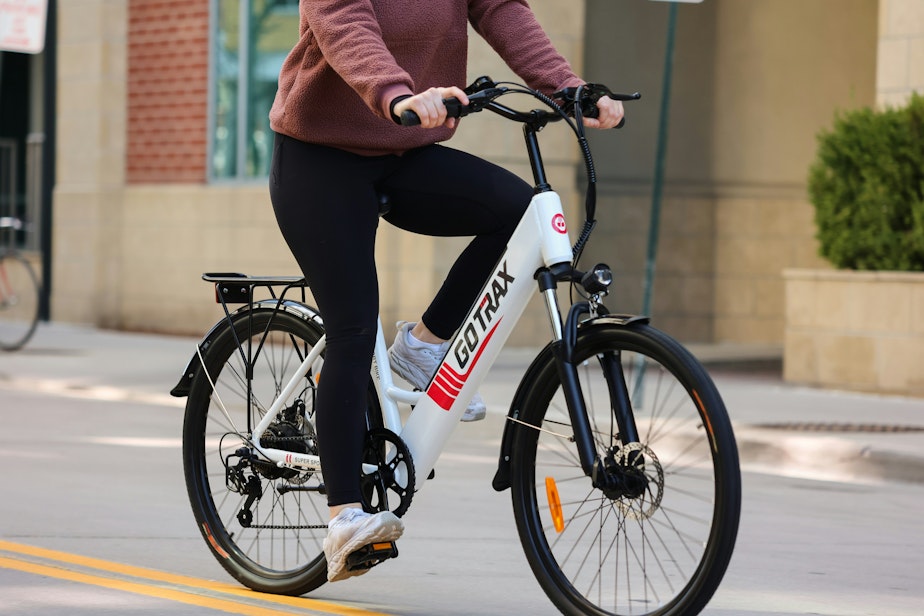E-bike fires are sparking trouble in Seattle. Here's how to use them safely

Seattle’s streets have become home to hundreds of electronic bikes and scooters in recent years, with a growing number of commuters and hobbyists relying on them to get around. As usage of these lithium-ion battery powered devices grows, so has the number of fires in connection with them. That’s prompted the Seattle Fire Department to urge caution when using and storing the devices.
Last year, Seattle Fire saw 22 of those fires, with nearly half occurring at apartments and houses. The department has responded to six so far this year.
Putting those fires out presents unique challenges, adding to officials’ concerns.
“Putting water on this type of fire is not normally enough to fully extinguish it because the compromised [battery] cells can reignite moments later,” Seattle Fire Department spokesperson David Cuerpo said in an email.
Also at play is that e-bikes and e-scooters often run on low-quality batteries, according to University of Washington chemical engineering professor Daniel Schwartz.
Sponsored
RELATED: Seattle: Scooters are dangerous. Tacoma: Wheeeee!
“They're still carrying a fair amount of energy,” he said. “But they tend to be the lowest cost, mass-produced battery products — less engineered, less safety standards.”
The U.S. Consumer Product Safety Commission on Monday issued a warning about Unit Pack Power (UPP) batteries, an after-market brand of lithium-ion batteries often used to power e-bikes. The notice follows several reports of fires and serious property damage caused by the batteries, which are manufactured in China and “have not been certified by an accredited laboratory to the applicable [Underwriters Laboratories] safety standard to ensure protections.” Underwriters Laboratories is widely considered the global authority on electronic product safety.
Schwartz likened lithium-ion batteries, generally, to unopened bottles of soda: The more they are banged up and mistreated, the more chances there are of something going wrong.
“The basic idea of a battery is that within a hair's distance from each other, you've got this strong oxidizer and a fuel that — if they touch each other — they burn,” Schwartz said.
Sponsored
RELATED: Trying all 5 shared e-scooters in Seattle, plus a unicycle
Those temperatures can get incredibly high, according to Seattle Fire.
“It can quickly burn in excess of 18,000 degrees Fahrenheit, emit toxic gasses, and overheat adjacent cells…causing a chain reaction known as thermal runaway where the compromised overheated cells catch fire or explode” Cuerpo said, emphasizing the need to handle those batteries with care.
Earlier this year, the City of Seattle announced a ban on throwing lithium-ion batteries in the garbage, requiring them to be disposed of through a special recycling program instead. Other cities like New York and San Francisco have enacted similar laws due to the batteries’ fire-starting potential.
Sponsored
RELATED: Rolling toward Washington state: support for e-bikes
Seattleites took roughly 4.9 million rides on city-sponsored e-bikes and e-scooters last year, a 32% increase in usage since 2022, according to Department of Transportation data. Ridership is on track to surpass that number in 2024 if a trend of increased monthly usage holds.
When it comes to private e-bike and e-scooter usage, lawmakers passed a state-funded rebate on the devices to help cut down on emissions. The rebate could knock $300 to $1,200 off of a purchase, depending on one’s income level.
For its part, Seattle Fire says there are obvious signs of lithium-ion battery trouble, like smoke or swelling. But the department is also warning users to be aware of weird smells coming from e-bikes and e-scooters, or batteries not holding a charge. Those scenarios signal that it’s time to safely dispose of the batteries.
Seattle Fire offers the following tips for using lithium-ion batteries safely:
- Keep your e-bikes, e-scooters, and batteries away from exit doors and anything hot or flammable.
- Only purchase and use devices, batteries, and charging equipment that are listed by a nationally recognized testing lab and labeled accordingly.
- Always follow the instructions from the manufacturer.
- Only use the battery and charger that came with your device.
- Stop charging your device as soon as it’s fully charged.
- Only charge one battery at a time to prevent overloading the circuit.
- Keep batteries at room temperature. Don’t charge them if it’s too cold (below 32°F or 0°C) or too hot (above 105°F or 40°C).
- Don’t leave batteries in sunlight or in hot cars. Keep them away from kids and liquids.
- Get a professional to fix your device if it’s broken. Don’t tamper with the battery on your own.
- Never throw lithium-ion batteries in the trash. It’s best to recycle them. Take the batteries to a battery recycling location or contact your local waste department for disposal instructions.




